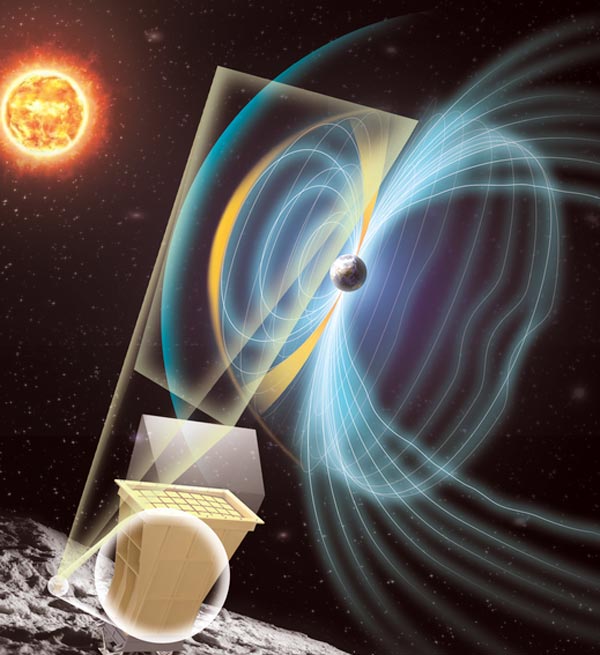A Lunar-based Soft X-ray Imager (LSXI) for the Earth’s magnetosphere

Concept artwork of observing the magnetosphere from the lunar surface.
Credit: Science China Press
The solar wind-magnetosphere coupling and its dynamic process are the basic driving factors for space weather. To understand its physical connotation, it is necessary to understand the processes of global scale responses, mass and energy transportation, and the coupling between different regions. However, relying on single-point or multi-point in-situ measurements is not enough for grasping the global effects caused by the solar wind disturbance, which is the key to understand how the Sun affects and controls the plasma and space weather.
The related paper, “A Lunar-based Soft X-ray Imager (LSXI) for the Earth’s magnetosphere”, was published recently in SCIENCE CHINA Earth Sciences. Professor Chi WANG from the National Space Science Center of the Chinese Academy of Sciences is the corresponding author. The team proposes to use the Moon as a platform to obtain a global view of Earth’s magnetosphere, by developing a Lunar-based Soft X-ray Imager (LSXI). LSXI is a wide field-of-view Soft X-ray telescope, which can obtain X-ray image of Earth’s magnetosphere based on the solar wind charge exchange (SWCX) X-ray emission.
For the past fifty years, based on a number of magnetospheric satellites, we have built a revolutionary understanding of magnetosphere structures and the physical evolution processes. At present, the majority of our knowledge on magnetospheric response to solar activities comes from in situ measurements of satellites and theoretical model analysis. Missions, such as Cluster and Double Star, have provided important information about the local plasma. However, due to the limited observation points, it is difficult to fully reveal the overall interactions of the solar wind with the magnetosphere at the system level and to predict the global dynamics.
Recently, a novel soft X-ray imaging technique has been developed, which is inspired by the lobster eye structure. This new type of instrument is a wide-field of view soft X-ray telescope with spectroscopic capabilities, and the detection principle is based on the recent discovery of solar wind charge exchange (SWCX) X-ray emission. This technique is becoming a powerful tool to achieve an unprecedented observational coverage of the magnetosphere and monitor the full chain interaction process of the solar wind and magnetosphere.
After successfully executing the early phases of CLEP, China is now proposing follow-up plans. In this paper, researchers have illustrated the concept of LSXI (Figure 1). Taking advantage of the position change between the Earth and Moon, LSXI will use the most advanced imaging technology to continuously observe the global images of the Earth’s magnetosphere. Furthermore, combining space-based and ground-based detection results, it will bring profound innovations to the research of magnetospheric physics, and will have direct application in predicting and mitigating space weather disasters. LSXI is led by National Space Science Center, CAS, in collaboration with institutions in China and abroad, including the Mullard Space Science Laboratory, University of Leicester (UK), and other research institutions. The time frame for launch is around 2027.
Compared with other observation schemes, a lunar platform has many advantages. Firstly, the Moon is in synchronous rotation with Earth, and thus always shows the same side to Earth. Therefore, the Moon becomes an excellent location for achieving a continuous observation of the solar wind-magnetosphere interactions. Secondly, the Moon is about 60RE away from the Earth. Therefore, the LSXI could cover the whole dayside magnetopause region including the bow shock, magnetopause and cusps. It will enable the global monitoring of the dynamic process during solar wind-magnetosphere interactions. Thirdly, the Moon is a permanent and stable observation platform. Its life cycle is not as limited as that of satellites. It is able to cover one or more solar cycles.
The work is supported by the National Natural Science Foundation of China (Grant Nos. 41731070, 41974211, 41774173, 41731070), the Key Research Program of Frontier Sciences CAS (Grant No. QYZDJ-SSW-JSC028), and the Strategic Pioneer Program on Space Science, CAS (Grant Nos. XDA15052500, XDA15350201).
See the article: Guo Y, Wang C, Wei F, Sun T, Yu X, Peng S, Branduardi-Raymont G, Sembay S. 2021. A Lunar-based Soft X-ray Imager (LSXI) for the Earth’s magnetosphere. Science China Earth Sciences, 64(7): 1026–1035, https://doi.org/10.1007/s11430-020-9792-5
Journal: Science China Earth Sciences
DOI: 10.1007/s11430-020-9792-5
Media Contact
Bei Yan
yanbei@scichina.org
Expert Contact
Chi WANG
cw@nssc.ac.cn
All latest news from the category: Earth Sciences
Earth Sciences (also referred to as Geosciences), which deals with basic issues surrounding our planet, plays a vital role in the area of energy and raw materials supply.
Earth Sciences comprises subjects such as geology, geography, geological informatics, paleontology, mineralogy, petrography, crystallography, geophysics, geodesy, glaciology, cartography, photogrammetry, meteorology and seismology, early-warning systems, earthquake research and polar research.
Newest articles

First-of-its-kind study uses remote sensing to monitor plastic debris in rivers and lakes
Remote sensing creates a cost-effective solution to monitoring plastic pollution. A first-of-its-kind study from researchers at the University of Minnesota Twin Cities shows how remote sensing can help monitor and…

Laser-based artificial neuron mimics nerve cell functions at lightning speed
With a processing speed a billion times faster than nature, chip-based laser neuron could help advance AI tasks such as pattern recognition and sequence prediction. Researchers have developed a laser-based…

Optimising the processing of plastic waste
Just one look in the yellow bin reveals a colourful jumble of different types of plastic. However, the purer and more uniform plastic waste is, the easier it is to…



